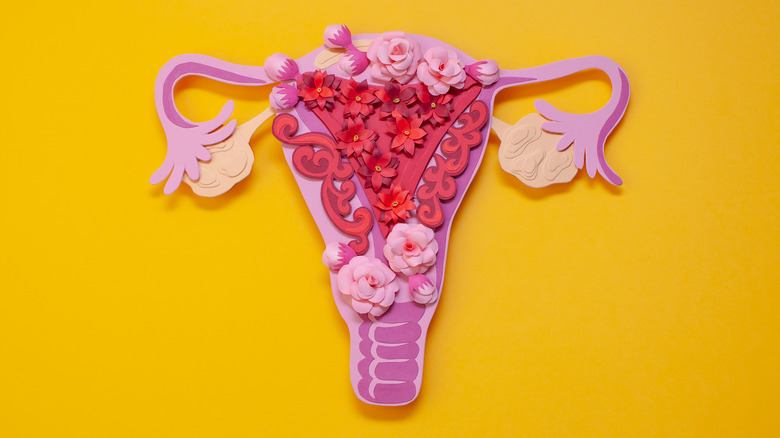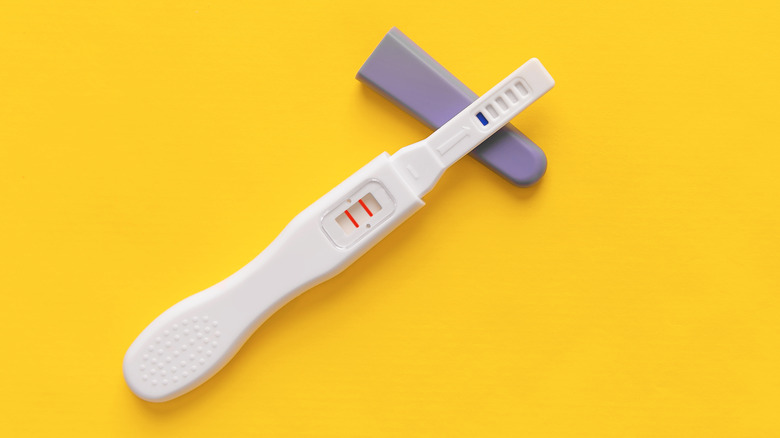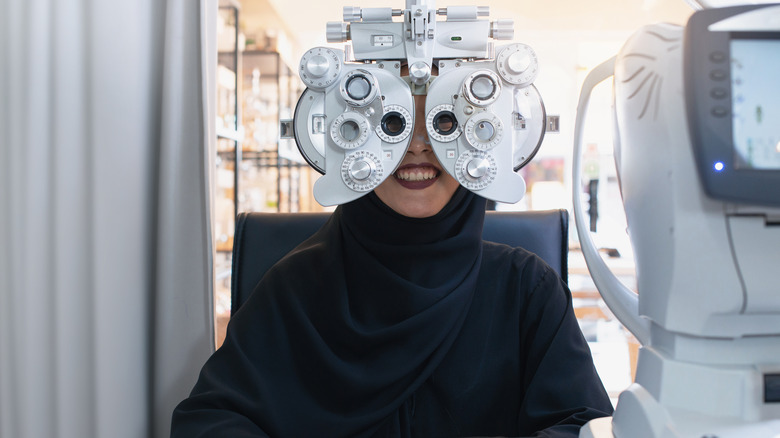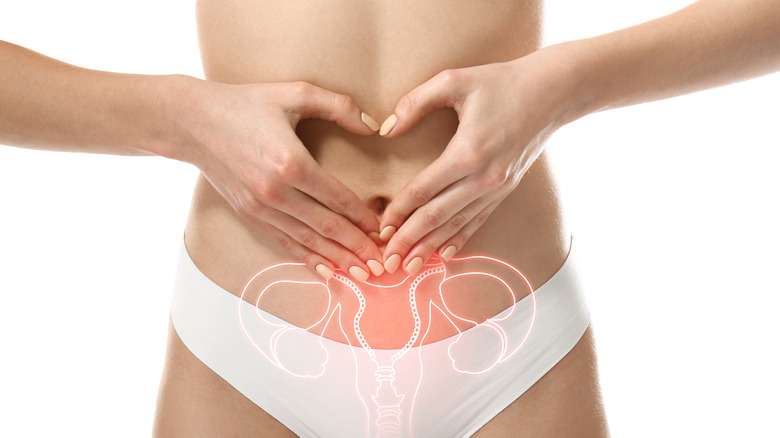Things About The Female Body People Don't Understand
Author Marianne Williamson famously wrote, "Our deepest fear is not that we are inadequate. Our deepest fear is that we are powerful beyond measure." In a way, this precisely describes the female experience. As a woman, you may have been told, or made to feel, that you were less than — less powerful, less important, et cetera — but all female-identifying people know one thing to be true: We are far stronger than some are willing to give us credit for.
We have watched women break athletic records after giving birth, care for entire families while sick, and breastfeed infants into toddlerhood. In addition to our seemingly superhuman strength, there are quite a few other things about women's bodies that most people don't totally understand (via The Guardian). After all, we are made of sugar, spice, everything nice ... and a whole lot of desirable mystery! Let's take a look at some of the most widely misunderstood aspects of the female body.
Women are more prone to anxiety than men
Anxiety is a fickle thing. About 19% of people in the United States are living with anxiety disorders (via the National Alliance on Mental Illness). Women tend to experience anxiety more frequently and aggressively than men. No, this is not just a trope portrayed in pop culture.
A study published in the Iranian Journal of Psychiatry and Behavioral Sciences breaks down why women are so much more anxiety-prone than men. The study specifically looked at Generalized Anxiety Disorder (GAD), which is one of a handful of anxiety disorders. GAD presents as chronic worrying about everyday life to the point that productivity and functionality are compromised. This can be caused by genetic and environmental factors, according to the National Alliance on Mental Illness.
Women and girls typically have far more metacognitive thoughts than men, which leads to increased levels of anxiety. This means that women are more aware of the thoughts they have about anxiety compared to men, and they ultimately try to avoid or control these thoughts.
Vaginas are capable of cleaning themselves
Existing in a world designed by and for men has led to myriad falsehoods surrounding our most sensitive yet powerful organ: the vagina. Vaginas are self-cleaning and this fact still blows our minds (via NHS).
With a healthy diet and a moderate amount of exercise, vaginas are able to stay in tip-top shape, generally speaking. Mucus from the cervix helps keep unwanted bacteria and other foreign matter from infiltrating and taking over. This mucus gets expelled from the body, though the intensity of this varies as hormones fluctuate, which appears as vaginal discharge. This is one of the main ways that vaginas keep themselves clean.
Vaginas also have a homeostatic pH that they work hard to maintain. This is one of the reasons that gynecologists do not recommend douching or using scented soap to clean the interior of this superstar sex organ. Soaps and even water can throw the pH out of whack, which can lead to itchiness and generalized discomfort. There is some evidence to support that douching might even leave you more susceptible to STIs and other infections. When left to its own devices, the vagina put in the work to keep its pH in check and discharge any unwanted invaders.
Strength training won't make you bulky
The days of using the excuse "I don't want to get bulky" to avoid exercise are over. Women who want to tone their bodies may get caught in the hamster wheel of diet, cardio, and restriction. There is a better way, y'all, and it's strength training!
Lifting weights is a great way to jumpstart your metabolism and burn more calories, even while you're resting. Muscle requires more energy to support than fat so if you create more muscle, your metabolism starts cranking to maintain it, according to Shape. As you lift, your body starts to adapt by creating shapes via your muscles in a way that cardio simply can't. Lifting heavy weights is a great way to create a foundational base, which leads to a toned aesthetic.
If you do want to increase your bulk as well, you should eat an excess of clean, protein-laden calories to achieve maximal muscle growth. Even with this excess in calories, your body won't start to look like Michael Phelps'. Finally, female bodybuilders didn't just wake up one day with well-fed muscles. It takes years of work (via Shape). Strength training's benefits far outweigh the negatives so go pick up that dumbbell, girl!
Women feel pain differently than men
It is easy for us to assume that women are better at dealing with the pain based on evolution and childbearing, but emerging scientific evidence actually disproves this theory. Women and men feel and process pain differently, but there isn't conclusive research to show that women are better at dealing with pain than men.
Studies have shown that women feel pain more acutely than men. Women are also more likely to experience fibromyalgia, tension headaches, irritable bowel syndrome, and other ailments when compared to men, highlighted one study published in The British Journal of Anaesthesia (BJA). However, research has been unable to prove the a critical element when it comes to determining pain threshold. It is incredibly complicated to study how the severity of pain differs between genders. Women are more likely to report pain, but that doesn't necessarily mean that women are more physically sensitive.
When studying a group of post-op patients, researchers found that the results varied and were ultimately inconclusive. Men and women respond differently to pharmaceutical protocols and, ultimately, the wide range of biological and psychosocial processes makes it difficult to determine who is stronger when it comes to pain, according to the study published in the BJA. For now, it seems like we will have to live without knowing.
Women process alcohol differently than men
It's a commonly held belief that women don't tolerate alcohol as well as men due to their often smaller size, but research shows that alcohol tolerance is far more complex than just body weight.
According to the National Institute on Alcohol Abuse and Alcoholism (NIAAA), "Women absorb and metabolize alcohol differently than men. In general, women have less body water than men of similar body weight, so that women achieve higher concentrations of alcohol in the blood after drinking equivalent amounts of alcohol."
Additionally, a study published by the NIAAA found that "male volunteers eliminated alcohol at significantly faster rates than did female volunteers." This is because women produce less alcohol dehydrogenase (ADH), an enzyme that helps break down alcohol (via BBC). Body fat percentage is another factor at play. Fat retains alcohol more than muscle, and women naturally have body fat in larger quantities, as BBC explained.
Women can get pregnant 'regardless of the circumstances of how that sperm got there'
Sadly, there are still some people who believe that women's bodies shut down and cannot produce a viable pregnancy if fertilization occurs as a result of rape (via The Week). However, the CDC explains that "rape-related pregnancy (RRP) is a public health problem," with nearly 3 million women experiencing RRP within their lifetimes. The CDC further revealed that 18 million women have experienced vaginal rape, so an estimated 17% out of these women thus also experience RRP.
Biologically speaking, women can, and do, get pregnant when they are raped. "Physiologically, if the sperm is in the vagina, a pregnancy can occur, regardless of the circumstances of how that sperm got there," Dr. Melisa Holmes, an OB-GYN, told LiveScience (via Business Insider). As to why the myth persists, Holmes said it comes down to a "simple lack of education into the human body." But make no mistake, "the reproductive system is going to respond in the same way whether it's rape, or you're madly in love with someone. It's tubes and pipes and sperm and eggs, and there's nothing that will stop that process," Holmes confirmed.
If you or anyone you know has been a victim of sexual assault, help is available. Visit the Rape, Abuse & Incest National Network website or contact RAINN's National Helpline at 1-800-656-HOPE (4673).
Typically, only giving birth can stretch out vaginal tissues
Having a lot of sex will not stretch out your vagina. "Unless you are engaging in practices that are out of the ordinary, I would say absolutely not." OB-GYN Alyssa Dweck told Health. The excess of blood flow and nerves creates a forgiving area that can shape-shift at will. With arousal comes lubrication and slight expansion to accommodate the impending activities. But once the said activities come to an end, the vagina springs back to its pre-arousal size.
Conversely, when a woman gives birth, the vagina may change slightly. This is especially common when women give birth to large babies or end up tearing the opening while delivering. Even so, the vagina harnesses its amazing superpowers and can spring back into shape. "A 10-pound baby could pass through the vagina, and although things may not go back to 100% the same after that, they sure go back to almost normal," Dr. Dweck confirmed to Health.
Women have exceptionally strong senses
If you're married or in a long-term relationship with a man, you may have accused him of not listening when you speak. This is, to an extent, true and the validation of this is incredibly exciting for wives everywhere. However, men do process information differently than women. A study conducted by Indiana University didn't necessarily say that women are better listeners, but they did prove that women listen with both sides of their brains (via Science Daily). Men, on the other hand, listen with one side.
Though there might not be enough evidence to prove that women are better listeners (sorry), there is plenty of evidence to prove that women excel when it comes to sniffing things out, literally. Women have keener senses of smell and, somewhat unfairly, male body odor is much more pungent (via Scientific American). You win some, you lose some, right?
Women can see more colors
Women can see a wider array of colors than men — and not just the one in 12 who are colorblind (via Healthline). It is always a good time to ask a heterosexual couple what color something is. The man may say red, while the woman says magenta, and so on. But why is this? Research has shown that women are better able to articulate the colors they are seeing in addition to their fine-tuned ability to detect slight changes in gradation.
Women are able to distinguish between itty bitty changes in color, especially in the middle of the color spectrum, whereas men perceive those colors to be identical, according to research conducted by Israel Abramov, a professor at CUNY's Brooklyn College (via Lions Talk Science). The researchers in this case also tested men and women's abilities to distinguish between light and dark bars flashing across a screen. The men beat out the women in this specific challenge. Experts agree that testosterone might be the reason for these visual differences.
Women make testosterone too!
Testosterone is known as the male sex hormone, but women make it too. And guess what? In female bodies, testosterone is made in the ovaries — the same organs that produce estrogen, the female sex hormone. However, testosterone is generally produced and absorbed into the bloodstream in smaller amounts than estrogen, according to WebMD.
Testosterone helps women's bodies function normally, but an excess of this hormone can lead to health problems. In some women with too much testosterone, fertility becomes a struggle. Many women with an excess have trouble getting pregnant and may struggle with weight issues, acne, thinning hair, and menstrual irregularities. If you suspect your testosterone levels might be too high, it is wise to consult your doctor.
For the mechanisms to work harmoniously, balance is best — as with so many things in health and wellness. When females bodies are functioning optimally, a mixture of testosterone and estrogen should be released by the ovaries (per WebMD).
The vagina can shrink after meonpause
Menopause is a change that delights, surprises, and wreaks havoc on female bodies around the world. One of the lesser-known facts about menopause is that it can cause the vagina to shrink (via The New York Times). Because menopause is the biological marker that indicates the conclusion of a woman's childbearing years, hormones go wild before leveling off. This is likely what causes the hot flashes and mood swings (via WebMD). The decrease in hormone levels has lasting effects on the vagina as well.
With a decrease in estrogen, the vagina becomes less elastic and the tissues become tighter, drier, and thinner. This also changes the homeostatic pH of the vagina causing it to become slightly more acidic, similar to the way it was in your pre-pubescent days, according to the North American Menopause Society (NAMS). Since the vagina tissue atrophies with this change, the vagina as a whole might become narrower and even shorter. All of this can come together to create a less comfortable sexual experience when penetration is involved.
It is recommended that women who are going through menopause continue to stay sexually active to help keep the vaginal walls healthy. Not all women experience this, but for those who do, it is helpful to be prepared for what might be on the horizon!
Cellulite and breast asymmetry are normal
Some women are insecure about their cellulite and the asymmetry of their breasts, while others are not. Either way, we salute you, and we are here to set the record straight. Cellulite and lopsided breasts are normal, to be expected, and truly, nothing to stress about!
Women have three layers of fat surrounding the hips, thighs, and butts, creating a playground for cellulite to rear its perfectly normal head! Cellulite is created by fat cells that start to push through collagen, which is why it is lumpy. As women age, the amount of estrogen we produce starts to fade, which affects the blood vessels and inhibits circulation to many of these superficial areas (per Scientific American). Approximately 90% of women have cellulite and while the beauty industry loves to prey upon physical insecurities, the creams that are available only target fat cells, not the cellulite itself. Since it's so normal, you may just want to roll with it!
Like cellulite, breast asymmetry is also common. According to Healthline, it affects more than 50% of all women. Breasts can change in size, shape, volume, and fullness because of hormone fluctuations. They can also change shape based on where you are in your menstrual cycle. So, while some women might have more noticeable breast-size discrepancies, it is completely normal. As long as you are doing your monthly self-examinations and taking care of yourself, you shouldn't worry about a cup-size difference (via Healthline).
This body part has nothing to do with virginity
Whether or not a woman's hymen is intact has nothing to do with her virginity. The only thing that affects her virginity is whether or not she has had sex. While penetrative sex can potentially break the hymen, it often breaks prior to a woman's first sexual experience (via Planned Parenthood). But let's back up a little and explain what a hymen is.
As Planned Parenthood explained, the hymen is a small flap of flesh that exists at the opening of the vagina. It typically does not cover the entire vaginal opening, though the size of the hymen varies from person to person. Since they vary, it is hard to determine when or how they might be stretched open. In most cases, the hymen has a hole that is large enough to accommodate a tampon comfortably and for menstrual blood to be released.
Women are born with different degrees of coverage, and the hymen can be stretched open from athletic endeavors, tampon use, and plenty of other activities. "So you can't tell if someone has had sex by the way their hymen looks or feels," Planned Parenthood confirmed.
Only spotty evidence has ever supported this myth
Perhaps one of the most mystifying things about the female body is the G-spot. Does it exist? Where can one find it? Do all women have these tiny erogenous zones made up of spongy tissues? And if they exist, how come so many people have trouble finding their exact hiding spots? The concept of the G-spot became widely accepted by the general public after the idea appeared in a popular book in 1982, according to a report in the American Journal of Obstetrics and Gynecology. Ah, the '80s.
The evidence to support that this spot exists is spotty and anecdotal. The sheer amount of question marks in this paragraph reinforces what gynecologists worldwide believe to be true, the G-spot might just be a myth, and a puzzling one at that (via Cosmopolitan). Can you imagine if Bigfoot had this kind of PR? We'd all be hiking in the Pacific Northwest every day to catch a glimpse. But, hey, many would still argue that he isn't a myth.















